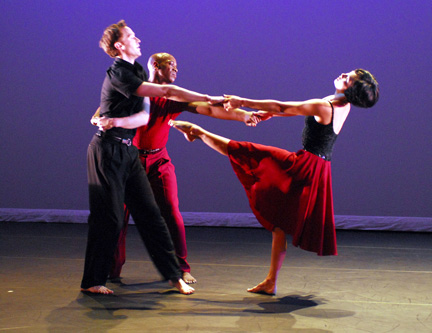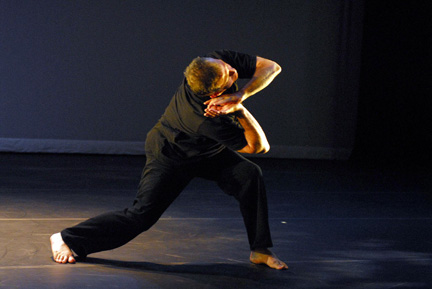An Evening at Home
The Mark Morris Dance Group
“The Argument,” “Sang-Froid,” “Italian Concerto,”
“Love Song Waltzes”
James and Martha Duffy Performance Space
Mark Morris Dance Center
Brooklyn, New York
January 17-20
by Nancy Dalva
copyright 2007, Nancy Dalva
 The James and Martha Duffy Performance space is a dance studio that converts, with risers and very comfortable padded chairs, to an intimate theater, holding, in the configuration for these performances at the Mark Morris Dance Center, 139 people. Have you ever wondered what it might have been like to live in Salzburg, or Vienna, in a grand house, and hire, for your evening’s entertainment the finest musicians, for your own musicale? This is what I imagine that was like, but the house is the house that Mark Morris and his amazing staff have built, and that now belongs, lucky us, to those who love dance. This concert experience, in this space, was the equivalent of chamber music, in dance terms. Intimate, with a luxury of detail and relationship. An inherently joyful evening, on a human scale, with the dancers not twenty feet away. The evening I was there, Mark Morris had just returned from working on his “Orfeo,” which will open at the Met in the spring. From the epic, to the intimate. It is part of his genius to find each of those qualities residing in the other.
The James and Martha Duffy Performance space is a dance studio that converts, with risers and very comfortable padded chairs, to an intimate theater, holding, in the configuration for these performances at the Mark Morris Dance Center, 139 people. Have you ever wondered what it might have been like to live in Salzburg, or Vienna, in a grand house, and hire, for your evening’s entertainment the finest musicians, for your own musicale? This is what I imagine that was like, but the house is the house that Mark Morris and his amazing staff have built, and that now belongs, lucky us, to those who love dance. This concert experience, in this space, was the equivalent of chamber music, in dance terms. Intimate, with a luxury of detail and relationship. An inherently joyful evening, on a human scale, with the dancers not twenty feet away. The evening I was there, Mark Morris had just returned from working on his “Orfeo,” which will open at the Met in the spring. From the epic, to the intimate. It is part of his genius to find each of those qualities residing in the other.
How interesting that after making “Mozart Dances,” a grand evening length work set to two concertos and a sonata for piano and orchestra, Mark Morris has chosen next to make an 12 minute work set to a Bach concerto notable for being the ultimate example of an entire orchestral concerto written for and expressed by a solo pianist. For “Mozart Dances” is a masterwork, the kind of piece which colors not only everything that comes after it, at least for a time, but also what came before it. Seeing “The Argument” (1999) and set to Schumann; “Sang-Froid” (2000) set to Chopin; and “Love Song Waltzes” (1989), and made to and for the Brahms “Liebesliederwalzer" again this week, I found myself apprehending them through the prism of the “Mozart Dances.” Some of this resonance, perhaps, comes from the dancers, who having danced the Mozart, bring something of it to whatever they next do. But more, I think, it has to do with the viewer, now primed to see certain constructions, certain patterns, certain qualities — whether it be a ruffle, a flourish, or an uncanny propensity to infuse dark with light, and light with dark. There are other kinds of masterpieces — for instance, the Morris “Dido and Aeneas” (seen incidentally, in its film version as part of the Dance on Camera series at Lincoln Center the week before) — that stand alone. They are perfect, self-contained, entire worlds onto themselves. But then there are these other materpieces, these works that swoop the past up into themselves in sublime reference and recurrence, and yet suggest the future.
 And here the future was: “Italian Concerto,” a delicious bon-bon of a dance with a strange and mysterious center. A chocolate truffle, if you will, with Mark Morris as the filling. With Colin Fowler sparkling at the piano, the Allegro of the piece opened in a duet for Amber Darragh and David Leventhal, with the establishing grand chords of the piano paralleled by an establishing dance gesture. A raised hand, a clenched fist, and then the five fingers opening. This motif repeated later, notably, in the Morris solo. A gesture of triumph? A simple announcement that the dance is for five people? Something much deeper? Indeed, the entire piece is filled with gesture. Perhaps it reflects the translational nature of the music itself, with Bach introducing the Italianate into the Germanic.
And here the future was: “Italian Concerto,” a delicious bon-bon of a dance with a strange and mysterious center. A chocolate truffle, if you will, with Mark Morris as the filling. With Colin Fowler sparkling at the piano, the Allegro of the piece opened in a duet for Amber Darragh and David Leventhal, with the establishing grand chords of the piano paralleled by an establishing dance gesture. A raised hand, a clenched fist, and then the five fingers opening. This motif repeated later, notably, in the Morris solo. A gesture of triumph? A simple announcement that the dance is for five people? Something much deeper? Indeed, the entire piece is filled with gesture. Perhaps it reflects the translational nature of the music itself, with Bach introducing the Italianate into the Germanic.
For Darragh and Leventhal, some of the embedded gestures were hand- to- elbow, hand- to- hip. They were, overall, a couple matched in lightness and delight–the world “couple” being operative. This duet, as were all the duets on the perfectly chosen program, little relationships, little stories, all told by structure and steps. Parallel means one thing. Echo means another. Facing means one thing. Chasing means something else. About three minutes and 51 seconds long, the Allegro romanced us into the piece.
Then came Mark Morris to dance the Andante, which runs just under five minutes. Wearing a black polo shirt and black trousers, he stood at the back of the stage, which was simply framed in four sets of black side curtains. He loomed large, looking out at us directly, and patted his chest — his sternum — with his open hand. Then came the gesture with the raised arm; the fist; the open fingers. That statement made, Morris started to lumber towards us, leading with his back at times, concentrating his force and weight into a downward spiral, and pointing to the ground with crossed hands. He looked something like a Kodiak, something like a Samurai: So let us say, a Samurai bear doing a hibernation dance. After he danced this passage, he returned upstage and repeated it, mostly, again. Just as Bach’s repeated motifs unspooled beneath him, as a contemplative pathway. Italian, Bach, Mark. (Music the ground, the given.) The movement looked like an exploration, and it looked new.
Finally came the Presto, a mere three and a half minutes of musical delight and mastery, here interpreted by Julie Worden, in femme fatale mode, and the young Dallas McMurray, whose pursuit of her is just delicious. The outside of that chocolate truffle, then. Mmmmmmmm. The piece then ends with the entire cast (five!), with Morris dancing on the far right end of the line. Is he the odd man out? Or the master stepping in? No matter, you feel his delight in the piece, as you might feel Bach’s delight, too, in his piece. What pleasure!
This company is now at a particularly gorgeous moment in its loveable and handsome history of 25 years, and counting. A company of virtuosi who are a dedicated ensemble. A company of personalities who, in various combination, yield greatly different effects in a richly varied repertoire. In other words, a real repertory troupe, the kind that one used to yearn for in the American theater. We have one now. It resides in Brooklyn, and is made up of dancers. It is the Mark Morris Dance Group.
Photos, both by Stephanie Berger:
First, "Love Song Dances."
Second, "Italian Concerto."
Volume 5, No. 4
January 22, 2007
copyright ©2007 Nancy Dalva
www.danceviewtimes.com